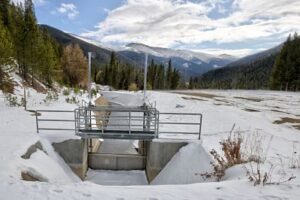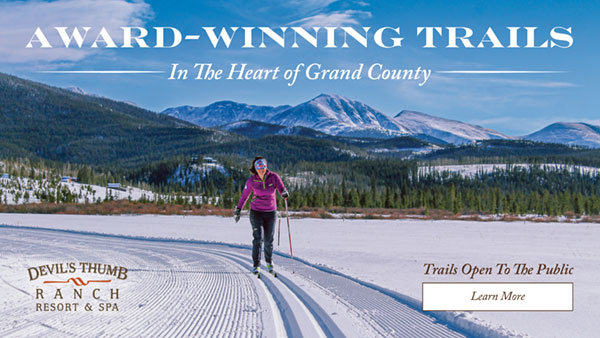The storms of October and a deep early chill left their indelible mark on our landscape as fall quickly morphed into winter. The snowy covering over the land has thus far resisted the attempts of the weakening November sun to erase the premature hold on most of our trails. The south-facing sage-dotted slopes have succumbed to the sun’s radiant melting powers, but in spite of temperatures porpoising above freezing with daily regularity, the trail conditions have held up very well.
Popular trails are becoming well packed, as many footfalls or ski tracks on warm snow make a trail hard and fast when the temperature makes its evening descent below the freezing point. The un-packed snow to the trail’s side is taking on a variable consistency. The warm snow of the mid-day remains powdery, but with a bit of a sugary, fine-grained meringue-feeling underfoot. As the shadows grow long, the cooling afternoon air hardens the thin surface layer the way a lightly browned and crisped marshmallow develops a shell. Even snow can get scorched by the heat of the mighty Sol. Sunny spots near dark evergreens increase the melting factor, leaving icy patches where more sunny days will bring tree-effect bare spots the way late season warmth creates tree wells.
The end of October’s bitter blast of cold that shocked us into wondering where on the calendar we stood, resulted in freezing-over of slower moving water on some of our creeks. The warmth of the afternoons raises questions about the ability of the newly and barely-formed snow bridges to support ones body weight. The air has indeed been March-like, with a sublimated humidity that hangs above a sunshine-warmed snowpack reminding us of spring afternoons.
The long range forecast looks like more of the same through mid- November. A string of sunshiny days with the thermometer bobbing up and down across the freezing point appears to be the predicted pattern for the foreseeable future. With no new snow to hit the refresh button, local favorite trails will start to feel a bit used. Exploring lesser-used routes, seeking more shaded trails and going higher in elevation should result in better snow conditions.
 For newcomers to the Fraser valley, the surrounding mountains and forests and wilderness can be a wondrous world for exploring, hiking, skiing or hunting. One of the unique features that might be encountered by going in most any direction from our valley into those mountains includes the myriad aqueducts and canals that are used to move water from our creeks across the divide to the dry, rain-shadowed, populous and thirsty Front Range. These canals are to be avoided at all costs, winter and summer. The steep, smooth cement sides do not provide for an easy way out should you venture close and have the snow on the edge give way, or should you somehow find yourself in one. Please, for your own safety, steer clear.
For newcomers to the Fraser valley, the surrounding mountains and forests and wilderness can be a wondrous world for exploring, hiking, skiing or hunting. One of the unique features that might be encountered by going in most any direction from our valley into those mountains includes the myriad aqueducts and canals that are used to move water from our creeks across the divide to the dry, rain-shadowed, populous and thirsty Front Range. These canals are to be avoided at all costs, winter and summer. The steep, smooth cement sides do not provide for an easy way out should you venture close and have the snow on the edge give way, or should you somehow find yourself in one. Please, for your own safety, steer clear.




